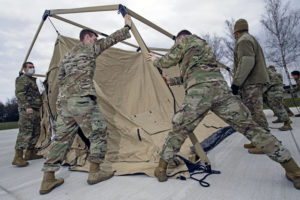
The 52nd Fighter Wing conducted specialized training on Spangdahlem Air Base as part of the Agile Combat Employment Academy Feb. 22-25.
The training taught Airmen in a range of career fields across the base how to perform a variety of different tasks from setting up tents to building cargo pallets in order to promote a highly flexible force, capable of deploying anywhere at a moment’s notice.
“When we go to austere locations, we don’t have the resources to take an entire base to support our mission,” said 1st Lt. Branden Ventura-Miller, 52nd Logistics Readiness Squadron Fuels flight commander and ACE Academy leader. “So what this is, really, is creating multi-capable Airmen who are equipped to do other people’s jobs so we can work with minimal people.”
ACE Academy is a training initiative held throughout the Air Force, and Spangdahlem maintainer Airmen have been participating in the program for some time, specifically emphasizing mission generation.

However, this is the first time the installation has supported a mission support variant of the academy. In order to create the refocused version, Ventura established the first base operation class for ACE in U.S. Air Forces in Europe-Air Forces Africa, and he established the training syllabus used during the four-day course.
“We never know when we’re going to be called to a different location,” said Ventura-Miller. “This really gives us the opportunity to pull as many Airmen as possible to help support the mission that will take place not here at Spangdahlem, but at other locations.”
Not only did participants learn from other Air Force career fields, but they also passed on a bit of their own expertise to the other participants.
Airmen from Spangdahlem’s medical, operations, maintenance and mission support groups and wing staff agencies both learned and taught occupational safety, public health, public affairs, LRS functions, and learning how to work generators.
A select few members also received leadership training they would need while deployed, like senior leader’s training for security forces, where they learned how to set up force support and security.

Some officer participants were taught how to fill in and manage as directors of operations.
“I definitely think it’s good training,” said Staff Sgt. Zachary Clement, 52nd Civil Engineer Squadron emergency management specialist, who was acting as a trainer for a portion of ACE Academy for the first time. “You never know what situation or place you’re going to be put into where you are going to be required to know some skills. It’s always great to be that guy who knows what you’re doing when it’s needed.”
Clement’s instruction revolved around tent-building, where participants were split up to build two tents in roughly half an hour. When it comes to being mission-ready anywhere, the NCO said this was a pretty important component.
“At Spangdahlem, we have a specialized team here known as the Initial Response Force, which at any time can be employed, and sometimes, when they are called, they will be required to set up a tent to possibly stage out of for command and control and living,” Clement said.

Clement also said having flexible Airmen at Spangdahlem makes the Air Force a better-capable partner alongside other nations from the North Atlantic Treaty Organization in the region.
“I think Spangdahlem is special in a way not only because people get to embrace the culture of the area, but you also have NATO forces and allies that we can work together and build a stronger team,” he said.
Ventura-Miller said the installation plans to host more training like this one.


